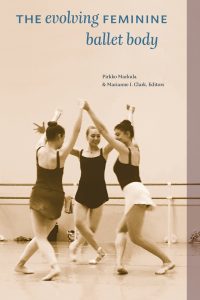Visit any children’s library and you’ll quickly learn the masculine ideal for Canadian boys is a burly figure in uniform – hockey player, fireman, cowboy – and the feminine ideal for girls is the ballerina. The Evolving Feminine Ballet Body counts some 30 children’s books illustrating “the belief that active bodies are thin, healthy bodies”. This is fascinating.
Editors and contributors examine perceptions of femininity through the magnifying lens of classical dance. They are not ballet critics; they number dancers, instructors and sociologists. Yet the conclusions are stark.
“Ballet has a strong attraction for many Canadian girls and women who do not strive to be professional dancers but nonetheless engage seriously in dance,” authors explain. Dr. Kate Davies of the University of Alberta notes: “Many Canadian girls and women have taken ballet class, owned a pair of ballet slippers, and worn a leotard with a tutu at some point in their lives.” The Evolving Feminine Ballet Body estimates 625,000 girls and women participate in dance classes.
The ballerina is a “feminine archetype” – skinny, shapeless, delicate, writes co-editor Marianne Clark. Interviews with dancers confirm the ideal of the “super thin” woman: “If you go to the ballet, none of the dancers have any hips and they are really tiny and perfect looking,” as one woman puts it.
“As a former ballet dancer and current contemporary dancer, I have engaged in many conversations with fellow dancers, parents of young dancers, and non-dancers alike that reveal both a fascination and frustration with the narrowly defined ballet body ideal,” writes Prof. Clark. “In these conversations, the ballet body is lamented as being oppressive for young dancers and as a problematic celebration of a particular and circumscribed idea of desirable femininity.”
These are not ruthless stereotypes invented by cosmetics manufacturers or media moguls; they are perpetuated by the 85 percent of dancers in Canada who are women, as estimated by the Council for the Arts.
Co-editor Prof. Pirkko Markula of the University of Alberta documents the spillover into popular culture. Markula chronicles the treatment of ballet dancers in the Canadian version of the reality show So You Think You Can Dance. Participants were typically described by judges in girlish terms: “princess”, “cute as a button”. One dancer was called a “little girl”; she was 18 at the time.
“We suggest the ballet body is important to examine now because we live in a world where all bodies face increased scrutiny and pressure to comply with stringent and often realistic ideals of beauty that are linked, often problematically, to notions of Western citizenship and morality,” editors write; “We invite further study into the myriad ways ballet reflects and upholds value systems as well as how it might shape, disrupt and provoke such systems in popular culture.”
The Evolving Feminine Ballet Body is fresh and compelling. Read it, and you can never look at a visit to the children’s library in quite the same way again.
By Holly Doan
The Evolving Feminine Ballet Body, by Pirkko Markula & Marianne I. Clark, editors; University of Alberta Press; 228 pages; ISBN 9781077212-3340; $24.95






